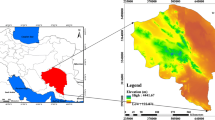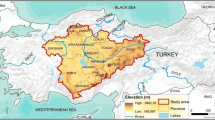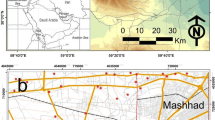Abstract
The fuzziness exists in spatial distribution of geographic data of land suitability evaluation processes, which makes it difficult to quantify land boundaries by using traditional binary logic-based overlay model. Aiming at this limitation, an ecological suitability evaluation analysis model was presented based on fuzzy theory and a research on urban growth boundary (UGB) of the Great-Hexi Leading District (GHLD) of Changsha was conducted. With the support of GIS, RS and MATLAB, slope, elevation, vegetation, soil productivity, soil permeability, water body and land use are selected as the input of model according to the characteristic properties of soil and terrain in red soil hilly areas. The running result of this model indicates that the ratios of highly suitable land, suitable land, moderately suitable land and unsuitable land in GHLD are 18.75%, 10.31%, 64.16%, 6.78%, respectively. This result accords with spatial structure worked out by Space Development Strategy Planning of GHLD. Based on this result, several suggestions are made to guide UGB developments in future.
Similar content being viewed by others
References
TAYYEBI A, PIJANOWSKI B C, TAYYEBI A H. An urban growth boundary model using neural networks, GIS and radial parameterization: An application to Tehran, Iran [J]. Landscape and Urban Planning, 2010, 26(3): 349–357.
LI Wei, XU Jian-chun. Study on spatial structure of Hangzhou city based on UGB [J]. Urban Studies, 2009, 16(4): 106–111. (in Chinese)
WEN Xin, ZHOU Lu, LI Dong-jiang. Matlab fuzzy logic toolbox analysis and application [M]. Beijing: Science Press, 2001: 1–4. (in Chinese)
ZHANG Xiao-xiang, YAO Jing, LI Man-chun. A review of fuzzy sets on spatial data handling [J]. Remote Sensing Information, 2005(2): 47–51. (in Chinese)
HE Ying-bin, CHEN You-qi, YANG Peng, WU wen-bin, YAO yan-min, LI zhi-bin. An overview and perspective of alien land suitability evaluation: study based on GIS technology [J]. Progress in Geography, 2009, 28(6): 898–904. (in Chinese)
ZADEH L H. Fuzzy sets: Information and control [J]. 1965, 8: 338–353.
RESHMIDEVI T V, ELDHO T I, JANA R. A GIS-integrated fuzzy rule-based inference system for land suitability evaluation in agricultural watersheds [J]. Computers & Geosciences, 2009, 101(1/2): 101–109.
NISAR AHAMED T R, GOPAL RAO K, MURTHY J S R. GIS-based fuzzy membership model for crop-land suitability analysis [J]. Agricultural Systems, 2000, 63(2): 75–95.
MOUTON M A, ALCARAZ-HERNÁNDEZ J D, BAETS B D, GOETHALS P L M, MARTÍNEZ-CAPEL F. Data-driven fuzzy habitat suitability models for brown trout in Spanish Mediterranean Rivers [J]. Environmental Modelling & Software, 2011, 26(5): 615–622.
SICAT R S, CARRANZA E J M, NIDUMOLU U B. Fuzzy modeling of farmers’ knowledge for land suitability classification [J]. Agricultural Systems, 2005, 83(1): 49–75.
BROEKHOVEN E V, ADRIAENSSENS V, BAETS B D, VERDONSCHOT P F M. Fuzzy rule-based macroinvertebrate habitat suitability models for running waters [J]. Ecological Modelling, 2006,198(1/2): 71–84.
NISAR AHAMED T R, GOPAL RAO K, MURTHY J S R. Fuzzy class membership approach to soil erosion modeling [J]. Agricultural Systems, 2000, 63(2): 97–110.
BOROUSHAKI S, MALCZEWSKI J. Using the fuzzy majority approach for GIS-based multicriteria group decision-making [J]. Computers & Geosciences, 2010, 36(3): 302–312.
Fuzzy logic toolbox tutorial [EB/OL]. [2011-03-04]. http://www.mathworks.com/help/toolbox/fuzzy/fp754.html.
FAO (Food and Agriculture Organization of the United Nations). A Framework for land evaluation. Soil bulletin, No 32 [R]. Rome: FAO. 1976.
Planning Administrative Bureau in Changsha, Urban Planning Design Institute in Shenzhen, Planning Design Consultant Limited Company in Changsha. Space Development Strategy Planning of Changsha GHLD [R]. 2008. ( in Chinese)
GORDON A, SIMONDSON D, WHITE M, MOILANEN A, BEKESSY S A. Integrating conservation planning and land use planning in urban landscapes [J]. Landscape and Urban Planning, 2009, 91(4): 183–194.
WANG Guo-en, XIAO Rong-bo, PENG Tao. Land intensive use planning and developing strategy in mountain city: Taking Zunyi as an example [J]. Modern Urban Research, 2010(2): 74–79. (in Chinese)
DUAN De-gang, LU Shou-yi, TIAN Tao. Some preliminary exploration of UGB establishment-management system [J]. Planners, 2009, 25(8): 11–14. (in Chinese)
GENNAIO M P, HERSPERGER A M, BURGI M. Containing urban sprawl-Evaluating effectiveness of urban growth boundaries set by the Swiss land use plan [J]. Land Use Policy, 2009, 26(2): 224–232.
ZHU Zhong-wen, MO Bin, XIE Fu-rong. Delimitation of urban growth boundary based on land ecological suitability evaluation: A case of Fangchenggang [J]. Planners, 2009, 25(11): 40–44. (in Chinese)
FENG Ke, WU Ci-fang, WEI Shi-chuan, LIU Yong. Urban expansion management: Review on the theory of UGB and its reference for China [J]. China Land Science, 2008, 22(5): 77–80. (in Chinese)
Author information
Authors and Affiliations
Corresponding author
Additional information
Foundation item: Project(2006BAJ04A13) supported by the National Science and Technology Pillar Program during the 11th Five-Year Plan of China; Project(2009FJ4056) supported by the Key Project of Science and Technology Program of Hunan Province, China; Project(20090161120014) supported by the New Teachers Fund of Department of Education, China
Rights and permissions
About this article
Cite this article
Jiao, S., Gao, Q., Wei, Cy. et al. Ecological suitability evaluation for urban growth boundary in red soil hilly areas based on fuzzy theory. J. Cent. South Univ. Technol. 19, 1364–1369 (2012). https://doi.org/10.1007/s11771-012-1151-x
Received:
Accepted:
Published:
Issue Date:
DOI: https://doi.org/10.1007/s11771-012-1151-x




